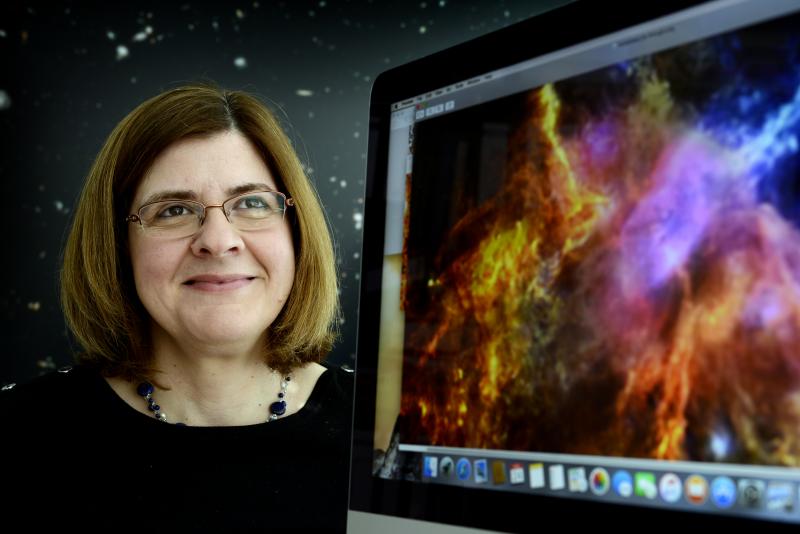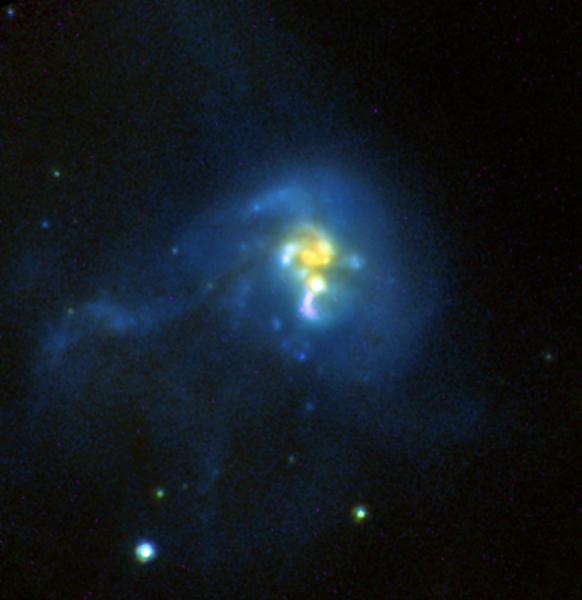BAA Ordinary Meeting, 2021 March 31
2021 October 3
The meeting was commenced by the President, Alan Lorrain. He said that a decision had been made to keep the subscription rate for the next session of the Association the same as for the current session.
He then introduced the evening’s speaker, Prof Dimitra Rigopoulou. She grew up in Greece and, after receiving a degree in physics, moved to the UK and obtained a doctoral degree in astrophysics at the Queen Mary University of London. She is currently a professor of astrophysics at the University of Oxford.

‘Lighthouses in the Universe: the tale of ultra-luminous infrared galaxies’
Prof Rigopoulou has been working on ultra-luminous infrared galaxies (ULIRGs) for most of her career and she started by thanking her colleagues for contributing to the information which would be presented in the talk.
An early classification of galaxies was undertaken by Edwin Hubble. His simple diagram is well known as the Hubble tuning fork. We now know this scheme was too simplified. However, for spiral, barred-spiral and elliptical galaxies, his classification method is still relevant. In this talk, Prof Rigopoulou would be discussing what are known as irregular galaxies.
The nearest ULIRG to us is in the Serpens constellation, at 250,000ly away (Arp 220). These galaxies are extremely luminous; 100 billion times brighter than the Sun. They contain vast amounts of dust, which obscures the stars. This dust is heated, allowing them to be observed in infrared.

To be counted as a ULIRG, a galaxy must have at least 1012 times solar luminosity, which makes them extremely rare. The first discovery was made by the satellite IRAS in 1983, as it was mapping the sky. This was followed with discoveries made by ISO in 1995, Spitzer in 2003, Herschel in 2009 and the ground-based radio telescope ALMA from 2012 onwards. The James Webb Space Telescope (JWST) will be launched in 2021 and will observe in the infrared.
We now know of 200–300 ULIRGs. These galaxies are mostly mergers, and almost always powered by star formation. It is also known that at least half have an active galactic nucleus (AGN).
Prof Rigopoulou continued by explaining why it is important to study ULIRGs. These objects signal the merging and morphological transformation of gas-rich galaxies. They can host incredible star formation and have complex, unique properties.
ULIRGs are the most luminous galaxies known in the local universe. 90% of their light is in the infrared and, in absolute terms, they are 100 to 1,000 times brighter in infrared than the Milky Way.
Prof Rigopoulou continued by showing two short videos of simulated interactions between a pair of galaxies, the first showing the stars and the second showing only the gas. The position of an AGN within a galaxy can be deduced by studying dominant star formation. The proposed structure involves a very dusty nucleus in the centre, which contains an AGN. It is possible, however, that the nucleus only comprises intense star formation.
Molecular gas is used very efficiently in ULIRGs to form stars. Far-infrared spectral emission lines show an abundance in the molecular clouds of the elements carbon, oxygen, and nitrogen, in either a neutral or an ionised state. Cooling via these emissions allows for cloud fragmentation in the early stages of star formation. It is unclear why, in ULIRG spectra, the carbon II line – an important indicator of cooling and hence cloud collapse and eventual star formation – is missing, when it is a key observable component in more normal galaxies.
Observations made by the Herschel space observatory show that many more ULIRGs are detectable at a greater distance, so they may have been more common in the past. It is possible that separate processes take place in these distant ULIRGs compared with more local ones, with differences in the way that the gas clouds interact and merge to form stars.
ULIRGs hold clues about the symbioses of black holes and star formation, interactions and mergers, and the birth of stars in the early and recent Universe. Studying them could therefore lead to a better understanding of the cosmos.
Mr Wilson thanked Prof Rigopoulou for her talk and she took a few questions. Mr Lorrain then introduced Owen Brazell, to give the Sky Notes. Mr Brazell is a well-known and respected expert on the deep sky and is president of the Webb Deep-Sky Society. He also regularly contributes to Astronomy Now.
‘Sky Notes’
Mr Brazell started by saying that this was the first time he had presented the Sky Notes. To begin with, he showed an image of the Moon by Steve Creasey. He presented two graphs which showed the level of darkness to be expected in the night sky over the following months, 2021 April and May, and went on to show the phases of the Moon during this time.
Nova Cas 2021 was discovered by Yuji Nakamura in Japan on Mar 18. This object could be associated with a W UMa-type double-star system. An image by David Swan showed the 7th-magnitude nova near M52 and the Bubble Nebula. This was followed with an image taken by Nick James. Spectra by Mike Harlow and David Boyd showed emission lines.
A prediction in a previous Sky Notes which indicated that alpha Orionis (Betelgeuse) would start to fade had, at the time of this meeting, not come to fruition to the extent expected. Mr Brazell asked for observations to be made before it was lost to the evening twilight.
Chi Cygni, which is a long-period variable that has been observed by the Association for 100 years, was at magnitude 5–6 magnitude. It can go down to 14th magnitude.
Sadly, unlike the previous year, we did not have many bright comets to observe at this time. C/2020 R4 (ATLAS) was at 9th magnitude and was the best hope for observation; an image by Peter Carson was shown. Midway through April was to be a good time to observe it. After that, the comet was set to start fading.
Recent data from the European Southern Observatory indicate that interstellar comet 2I/Borisov is a pristine object which may never have come close to a star before its recent visit to the solar system. It is a long way out and so not an easy target for amateur observation.
Mr Brazell then focused on planets. Mars was still visible in the evening sky at this time, but it would be becoming harder to observe. Jupiter and Saturn were visible in the early morning, but extremely low.
Observable meteors were lacking at this time. The April Lyrids would be visible from Apr 14–30, but this would not be a dramatic shower, with a zenithal hourly rate of 15. Continuing his discussion of meteoroids, Mr Brazell spoke a little about the Winchcombe Meteorite, and presented an image showing the meteor still in flight, taken by Richard Fleet.
On Mar 20 a sonic boom and sightings of a bright fireball were reported along the south coast of England. It is thought that a meteorite may have landed somewhere in the New Forest in Hampshire. No reports of any discovery had been made at this time.
The Sun was still napping and so activity was low. On Jun 10 there was to be an annual solar eclipse visible in the Arctic regions, whilst in the UK we could expect a 20–32% maximum phase.
Mr Brazell then spoke a little about the Realm of Nebulae, an area of the sky that includes the Virgo Cluster which contains some 2–3,000 galaxies. There were at this time plenty of galaxies available to observe, including objects visible through binoculars. Mr Brazell referred to the work of Adelaide Ames, who contributed to the study of galaxies and, in collaboration with Harlow Shapely, produced the Shapely–Ames Catalog of Bright Galaxies in the 1930s. In 1986, BAA member Le Forbes created a set of charts covering the Virgo cluster, which she based on photographs taken by Harold Ridley. Mr Brazell continued by showing a chart of the Virgo Cluster. He finished by showing an image of the black hole in M87 in polarized light, taken with the EVT (Event Horizon Telescope), which showed the magnetic fields.
Mr Wilson thanked Mr Brazell and the meeting was then closed.
Alan Dowdell, Meetings Reporter
https://britastro.org/wp-content/uploads/2022/02/Beecroft_Image_31s.jpeg
https://britastro.org/wp-content/uploads/2022/03/Beecroft_Image_31s.jpeg
https://britastro.org/wp-content/uploads/2022/02/Beecroft_Image_31s.jpeg
https://britastro.org/wp-content/uploads/2022/02/Beecroft_Image_31s.jpeg
https://britastro.org/wp-content/uploads/2022/02/Beecroft_Image_31s.jpeg
https://britastro.org/wp-content/uploads/2022/02/Beecroft_Image_31s.jpeg
https://britastro.org/wp-content/uploads/2022/02/Beecroft_Image_31s.jpeg
https://britastro.org/wp-content/uploads/2022/02/Beecroft_Image_31s.jpeg
https://britastro.org/wp-content/uploads/2022/02/Beecroft_Image_31s.jpeg
https://britastro.org/wp-content/uploads/2022/02/Beecroft_Image_31s.jpeg
https://britastro.org/wp-content/uploads/2022/02/Beecroft_Image_31s.jpeg
https://britastro.org/wp-content/uploads/2021/10/Beecroft_Image_31s_0.jpeg
https://britastro.org/wp-content/uploads/2022/02/Beecroft_Image_31s.jpeg
https://britastro.org/wp-content/uploads/2022/02/Beecroft_Image_31s.jpeg
https://britastro.org/wp-content/uploads/2022/02/Beecroft_Image_31s.jpeg
https://britastro.org/wp-content/uploads/2022/02/Beecroft_Image_31s.jpeg
https://britastro.org/wp-content/uploads/2022/02/Beecroft_Image_31s.jpeg
https://britastro.org/wp-content/uploads/2022/02/Beecroft_Image_31s.jpeg
https://britastro.org/wp-content/uploads/2021/10/Beecroft_Image_31s.jpeg
https://britastro.org/wp-content/uploads/2021/10/Beecroft_Image_31s_0.jpeg
| The British Astronomical Association supports amateur astronomers around the UK and the rest of the world. Find out more about the BAA or join us. |
